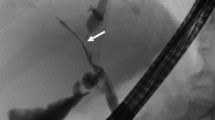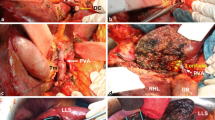Abstract
Background/purpose
Both curative resection and minimized in-hospital mortality offer the only chance of long-term survival in patients with hilar cholangiocarcinoma. The reported resectability rates for hilar cholangiocarcinoma have increased by virtue of combined major hepatectomy, but this procedure is technically demanding and still associated with a significant morbidity and mortality that must be carefully balanced against the chances of long-term survival.
Methods
Between January 2001 and December 2008, 350 patients with hilar cholangiocarcinoma underwent exploration for the purpose of potentially curative resection, of whom 302 (86.3%) were resected in the Department of Hepato-Biliary Surgery and Liver Transplantation, Asan Medical Center, University of Ulsan College of Medicine. Combined hepatectomy was carried out in 268 (88.7%) of 302 resected patients. Major hemihepatectomy and parenchyma-preserving hepatectomy were performed in 257 and 11 patients, respectively. Portal vein resection was associated in 40 (14.9%) of 268 hepatectomized patients. To control preoperative cholangitis and reduce risk of postoperative hepatic failure, biliary decompression through endoscopic and/or percutaneous transhepatic drainage and portal vein embolization were preoperatively applied in 329 (94.0%) of 350 explored patients and in 91 (54.2%) of 168 extended hepatectomized patients (154 right hemihepatectomy, 9 right trisectionectomy, 5 left trisectionectomy), respectively. Liver transplantation was not performed as primary treatment for hilar cholangiocarcinoma.
Results
There were 5 cases (1.7%) of in-hospital death after resection and 1 postoperative liver failure that was successfully treated with liver transplantation. Major complications were encountered in 23 patients (7.0%), and the overall morbidity rate was 43%. In 302 resections, 214 (70.9%) were curative resections (R0) and 88 (29.1%) were palliative resections (R1). The overall 1-, 3- and 5-year survival rates after resection, including in-hospital deaths, were 84.6, 50.7 and 47.3% in the R0 group and 69.9, 33.3 and 7.5% in the R1 group, respectively. The 5-year survival rate of extended hemihepatectomy of 36.4% was better than that of parenchyma-preserving hepatectomy at 10.5%. Two significant predictive factors adversely affecting survival after resection were lymph node metastasis and incurability of surgery (P < 0.001). Two patients with vascular involvement who underwent concomitant hepatic artery and portal vein reconstruction are alive after more than 3 years.
Conclusion
Preoperative biliary decompression and portal vein embolization enabled us to reduce in-hospital deaths associated with extended hepatectomy for hilar cholangiocarcinoma. Major hemihepatectomy offers an increased survival because of the higher possibility of curative resection than bile duct resection alone and parenchyma-preserving hepatectomy, but it still carries a certain mortality. Less extensive procedures can be conducted safely and are beneficial for aged patients in poor condition with a less advanced tumor stage if tumor-free resectional margins are obtained.



Similar content being viewed by others
References
Kawasaki S, Imamura H, Kobayashi A, Noike T, Miwa S, Miyagawa S. Results of surgical resection for patients with hilar bile duct cancer: application of extended hepatectomy after biliary drainage and hemihepatic portal vein embolization. Ann Surg. 2003;238(1):84–92.
Neuhaus P, Jonas S, Settmacher U, Thelen A, Benckert C, Lopez-Hänninen E, et al. Surgical management of proximal bile duct cancer: extended right lobe resection increases resectability and radicality. Langenbecks Arch Surg. 2003;388:194–200.
Sano T, Shimada K, Sakamoto Y, Yamamoto J, Yamasaki S, Kosuge T. One hundred two consecutive hepatobiliary resections for perihilar cholangiocarcinoma with zero mortality. Ann Surg. 2006;244:240–7.
Klempnauer J, Ridder GJ, Werner M, Weimann A, Pichlmayr R. What constitutes long-term survival after surgery for hilar cholangiocarcinoma? Cancer. 1997;79:26–34.
Nagino M, Kamiya J, Nishio H, Ebata T, Arai T, Nimura Y. Two hundred forty consecutive portal vein embolizations before extended hepatectomy for biliary cancer: surgical outcome and long-term follow-up. Ann Surg. 2006;243:364–72.
Shimada H, Endo I, Sugita M, Masunari H, Fujii Y, T anaka K, et al. Hepatic resection combined with portal vein or hepatic artery reconstruction for advanced carcinoma of the hilar bile duct and gallbladder. World J Surg. 2003;27(10):1137–42.
Lee SG, Lee YJ, Park KM, Hwang S, Min PC. One hundred and eleven liver resections for hilar bile duct cancer. J Hepatobiliary Pancreat Surg. 2000;7:135–41.
Ebata T, Kamiya J, Nishio H, Nagasaka T, Nimura Y, Nagino M. The concept of perihilar cholangiocarcinoma is valid. Br J Surg. 2009;96:926–34.
Hwang S, Lee SG, Ko GY, Kim BS, Sung KB, Kim MH, et al. Sequential preoperative ipsilateral hepatic vein embolization after portal vein embolization to induce further liver regeneration in patients with hepatobiliary malignancy. Ann Surg. 2009;249:608–16.
International Union Against Cancer (UICC). TNM classification of malignant tumors. 6th ed. New York: Wiley; 2002.
Hemming AW, Reed AI, Fujita S, Foley DP, Howard RJ. Surgical management of hilar cholangiocarcinoma. Ann Surg. 2005;241:693–702.
Miyazaki M, Kimura F, Shimizu H, Yoshidome H, Otsuka M, Kato A, et al. Extensive hilar bile duct resection using a transhepatic approach for patients with hepatic hilar bile duct diseases. Am J Surg. 2008;196:125–9.
Shimada H, Endo I, Sugita M, Masunari H, Fujii Y, Tanaka K, et al. Is parenchyma-preserving hepatectomy a noble option in the surgical treatment for high-risk patients with hilar bile duct cancer? Langenbecks Arch Surg. 2003;388:33–41.
Nagino M, Kanai M, Morioka A, Yamamoto H, Kawabata Y, Hayakawa N, et al. Portal and arterial embolization before extensive liver resection in patients with markedly poor functional reserve. J Vasc Interv Radiol. 2000;11:1063–8.
Nagino M, Kamiya J, Arai T, Nishio H, Ebata T, Nimura Y. “Anatomic” right hepatic trisectionectomy (extended right hepatectomy) with caudate lobectomy for hilar cholangiocarcinoma. Ann Surg. 2006;243:28–32.
Ikeyama T, Nagino M, Oda K, Ebata T, Nishio H, Nimura Y. Surgical approach to Bismuth type I and II hilar cholangiocarcinomas—audit of 54 consecutive cases. Ann Surg. 2007;246:1052–7.
Ebata T, Nagino M, Kamiya J, Uesaka K, Nagasaka T, Nimura Y. Hepatectomy with portal vein resection for hilar cholangiocarcinoma: audit of 52 consecutive cases. Ann Surg. 2003;238:720–7.
Kondo S, Katoh H, Hirano S, Ambo Y, Tanaka E, Okushiba S. Portal vein resection and reconstruction prior to hepatic dissection during right hepatectomy and caudate lobectomy for hepatobiliary cancer. Br J Surg. 2003;90:694–7.
Hwang S, Ha TY, Jung DH, Park JI, Lee SG. Portal vein interposition using homologous iliac vein graft during extensive resection for hilar bile duct cancer. J Gastrointest Surg. 2007;11:888–92.
Song GW, Lee SG, Hwang S, Kim KH, Cho YP, Ahn CS, et al. Does Portal vein resection with hepatectomy improve survival in locally advanced hilar cholangiocarcinoma? Hepatogastroenterology. 2009;93:935–42.
Hirano S, Kondo S, Tanaka E, Shichinohe T, Tsuchikawa T, Kato K. No-touch resection of hilar malignancies with right hepatectomy and routine portal reconstruction. J Hepatobiliary Pancreat Surg. 2009;16:502–7.
Miyazaki M, Kato A, Ito H, Kimura F, Shimizu H, Ohtsuka M, et al. Combined vascular resection in operative resection for hilar cholangiocarcinoma: does it work or not? Surgery. 2007;141:581–8.
Robles R, Figueras J, Turrión VS, Margarit C, Moya A, Varo E, et al. Spanish experience in liver transplantation for hilar and peripheral cholangiocarcinoma. Ann Surg. 2004;239:265–71.
Rea DJ, Heimbach JK, Rosen CB, Haddock MG, Alberts S, Kremers WK, et al. Liver transplantation with neoadjuvant chemoradiation is more effective than resection for hilar cholangiocarcinoma. Ann Surg. 2005;242:451–61.
Kitagawa Y, Nagino M, Kamiya J, Uesaka K, Sano T, Yamamoto H, et al. Lymph node metastasis from hilar cholangiocarcinoma: audit of 110 patients who underwent regional and paraaortic node dissection. Ann Surg. 2001;233:385–92.
Maeba T, Maeta H, Wakabayashi H, Okada S, Mori S, Karasawa Y. Modified hepatoduodenal ligamentectomy for advanced carcinoma of the biliary tract: the importance of preservation of the replaced left hepatic artery. J Hepatobiliary Pancreat Surg. 1998;5(3):297–302.
Author information
Authors and Affiliations
Corresponding author
About this article
Cite this article
Lee, S.G., Song, G.W., Hwang, S. et al. Surgical treatment of hilar cholangiocarcinoma in the new era: the Asan experience. J Hepatobiliary Pancreat Sci 17, 476–489 (2010). https://doi.org/10.1007/s00534-009-0204-5
Received:
Accepted:
Published:
Issue Date:
DOI: https://doi.org/10.1007/s00534-009-0204-5




